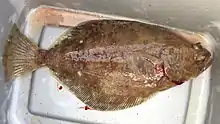Petrale sole
The Petrale sole (Eopsetta jordani) is an edible flatfish of the family Pleuronectidae. It is a demersal fish that lives on sandy bottoms, usually in deep water, down to depths of about 550 metres (1,800 ft). Males can grow to 53 centimetres (21 in) in length, females to 70 centimetres (28 in), and they can weigh up to 3.7 kilograms (8.2 lb). Its native habitat is the Eastern Pacific, stretching from the coast of Baja California in the south to the Aleutian Islands in the Bering Sea in the north.[2][3]
| Petrale sole | |
|---|---|
 | |
| Scientific classification | |
| Domain: | Eukaryota |
| Kingdom: | Animalia |
| Phylum: | Chordata |
| Class: | Actinopterygii |
| Order: | Pleuronectiformes |
| Family: | Pleuronectidae |
| Genus: | Eopsetta |
| Species: | E. jordani |
| Binomial name | |
| Eopsetta jordani (Lockington, 1878) | |
| Synonyms | |
|
Hippoglossoides jordani Lockington, 1879 | |
Petrale sole is an important commercial fish, caught all along the West Coast of the United States and Canada and into the Bering Sea, almost exclusively by trawler.[3][4][5]
Identification
Petrale sole is a right-eyed flounder with an oval body. Its upper surface is uniformly light to dark brown, and its lower surface is white, sometimes with pink traces. It has a large mouth with two rows of small, arrow-shaped teeth on the upper jaw and one row of teeth on the lower jaw.[5]
Diet
Juvenile petrale sole feed on cumaceans, carideans and amphipods, whilst adults will eat shrimps, crabs, epibenthos organisms and other fish, such as herring, hake, anchovy, pollock and other flatfish.[3]
Commercial fishing
The Petrale sole is an important commercial fish, and has been fished off Oregon since at least 1884. One fishery exists, off the west coast of the United States. Although Petrale sole are native to Alaska and are caught there and in other fisheries, no other designated Petrale sole fishery exists.[3][5]
Between 1995 and 2004 the coastwide catch of Petrale sole ranged from 1,616 to 2,377 tonnes. The Pacific Fishery Management Council has established Acceptable Biological Catch limits for the annual harvests of petrale sole in the waters off the US west coast; from 1995 to 2000 the coastwide total annual catch did not exceed the catch limit, but from 2001 the catch in the Northern assessment area has exceeded the portion of the catch limit attributed to that area.[3][4]
The estimated biomass of petrale sole in the northern segment of the fishery reached a historical low of 1,267 tonnes in 1992, but has increased steadily since then to 4,960 tonnes in 2005. The southern segment reached a historical low of 1,012 tonnes in 1986, and, after remaining stable for ten years, by 2005 it had increased to 4,667 tonnes.[3] Petrale sole was declared overfished in 2009 and then rebuilt in 2015 after a period of reduced catches.[6]
References
- Munroe, T.A. & Nielsen, J.G. (2017) [errata version of 2010 assessment]. "Eopsetta jordani'". IUCN Red List of Threatened Species. 2010: e.T154977A115257117. doi:10.2305/IUCN.UK.2010-4.RLTS.T154977A4681677.en. Retrieved 26 March 2018.
- Ed. Rainer Froese & Daniel Pauly (15 January 2009). "Petrale sole". Fishbase. Retrieved 2009-05-15.
- Lai; Haltuch; Punt; Cope (September 2005). "Stock Assessment of Petrale Sole: 2004" (PDF). US National Marine Fisheries Service. Archived from the original (PDF) on January 9, 2009. Retrieved 2009-05-15.
- "Washington - Oregon - California Petrale Sole - northern Stock". FishSource. Sustainable Fisheries Partnership. 2007. Archived from the original on February 23, 2012. Retrieved 2009-05-15.
- "Petrale Sole (Eopsetta jordani)". FishWatch. National Marine Fisheries Service. 14 May 2009. Retrieved 2009-05-15.
- "Petrale Sole | FishWatch". Archived from the original on 2018-12-04. Retrieved 2017-11-17.
